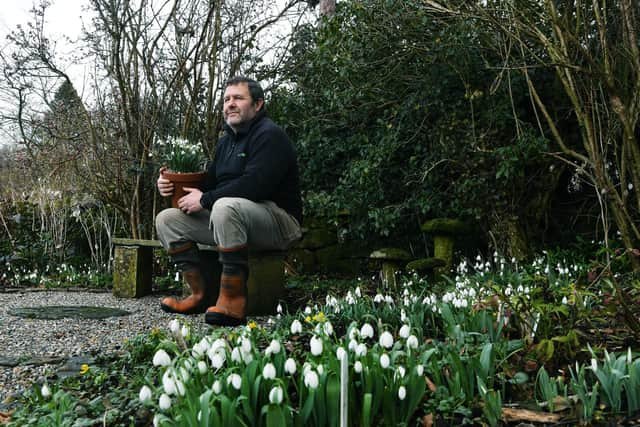Snowdrop collectors' delight as carpet of white blooms across Yorkshire
Now, as a carpet of white blooms across Yorkshire, collectors are watching with avid fascination.
While the humble snowdrop brings the promise of brighter days ahead, some bulbs can pass hands for princely sums at auction.
Advertisement
Hide AdAdvertisement
Hide AdWith February's festivals postponed, they are bursting into glorious displays for a select few still tending behind closed garden gates.


"The fact that snowdrops flower in winter calls to all of us," said collector Michael Myers, who has as many as 500 varieties in his Nidderdale garden alone.
"There is something that appeals about collecting. When you really get into snowdrops, you notice all the minute details."
February in Yorkshire usually sees snowdrop festivals, as stately homes and gardens open their doors to as many as 800 visitors a day.
Advertisement
Hide AdAdvertisement
Hide AdNow, even without witnesses, a carpet of winter white still begins to blossom.


Clare Oglesby, co-owner of Goldsborough Hall with husband Mark, first became interested in specialist varieties a decade ago. Now, she laughed, she has "a bit of a problem".
"I have 120 different varieties," said Mrs Oglesby. "There's a catalogue that comes and it's wonderful, I try and tick them off. There are some you just have to have."
The difference in snowdrops is intricate, she said. One is called 'Grumpy' because of a downturned smile on its petals, another is 'Polar Bear' because of its rounded ears.
Advertisement
Hide AdAdvertisement
Hide Ad"If you get them all together, in a walk, you can really see the differences," she said. "There's so much positivity to it, which is why it's so easy to get so enthused.
"When this dainty little thing pushes through, refusing to be crushed down by snow, they are a joy in the garden. They are so strong and resolute."
At Leeds' York Gate Gardens, head gardener Ben Preston had something special planned for the festival this year, with suspended Kokedama.
These Japanese moss balls, hung from trees with twine, make for dashing displays as a backdrop for the snowdrop varieties he tenders.
Advertisement
Hide AdAdvertisement
Hide AdHis is but a growing collection, he insists, as he readies instead for video tours instead to ensure their splendour can still be enjoyed.
"The big thing in snowdrops is yellow and gold, and the markings on the petals," he said. "Everybody strives for new and interesting. For me, I try to show people the differences we have got."
The names of the variations of flowers evoke a powerful image. There are bumblebee snowdrops, bitter lemons or Mother Goose.
Some have lime green splashes dotted on the winter white, others a dash of yellow. Some are identified by their flower shape, spotting or ovary.
Advertisement
Hide AdAdvertisement
Hide AdMr Myers estimates there may be as many as 2,000 different variations in Britain today, buried in specialist collections and cherished for their unique characteristics.
The enthusiast, who planted the first snowdrops in his Summerbridge garden in the mid 1980s, estimates he now has between 400 and 500 varieties.
In some specialist collections, he adds, they can flower from the Autumn.
"The majority of them, certainly up where we are, tend to flower in February," said Mr Myers. "It is that they flower in winter that makes them special, and valuable.
Advertisement
Hide AdAdvertisement
Hide Ad"That early flowering is the appeal. It epitomises the start of spring, with the first show of flowers sweeping into view. "
The most expensive snowdrop bulb ever sold went for £1,390 at auction in 2015, aptly named the 'Golden Fleece', created by a specialist near Cambridge.
Yet while the flower has come to hold such strong meaning at the turn of the season in Britain, they are not a native plant.
"There are suggestions it was introduced in the 17th century," said Mr Myers, who is a horticulture lecturer at Craven College and is known as Yorkshire's 'Snowdrop Man'.
Advertisement
Hide AdAdvertisement
Hide Ad"All these types of snowdrops we see would have come from Europe. There is not anything written about them being recorded before the 17th century.
"It was collectors from the late 19th century who have grown them in different types, and in the past 30 years that has really taken off."
Comment Guidelines
National World encourages reader discussion on our stories. User feedback, insights and back-and-forth exchanges add a rich layer of context to reporting. Please review our Community Guidelines before commenting.